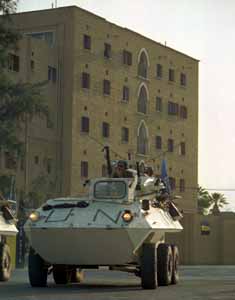




INTRODUCTION
GAIN ATTENTION
PURPOSE
INDIVIDUAL TRAINING STANDARDS
M0369.3.8, M0311.5.14
MISSION PERFORMANCE STANDARDS
M2A.16.10, M2A.9.16
TERMINAL LEARNING OBJECTIVE
Without the aid of references and in accordance with MCWP 3-34, the student will understand, discuss and demonstrate the employment of mobile patrols.
ENABLING LEARNING OBJECTIVES
1. Know the characteristics of mobile patrols.
2. Know the patrol organization.
3. Know the principles of mobile patrols.
4. Know the correct employment of a mobile patrol.
5. Know the immediate actions of a mobile patrol.
METHOD AND MEDIA
This period of instruction will be taught through lecture with the aid of assistant instructors.
TESTING
This period of instruction will be evaluated through practical application during situational training exercises.
TRANISTION
BODY
1. Characteristics of Mobile Patrols:
a. They capitalize on the speed, mobility and protection offered by the various vehicles that may be employed.
b. The patrol may be motorized, mechanized, composed of armored vehicles or of any combination.
c. Generally possesses greater combat power than dismounted patrols.
d. Can cover larger areas faster than dismounted patrols.
e. Has the ability to care more weapons, munitions and equipment than dismounted patrols.
f. Mounted patrols are easier to canalize into killing zones than dismounted patrols.
g. Mounted patrols cannot take advantage of the three dimensional aspect of the urban terrain.
2. Patrol Organization:
a. The mounted patrol is generally organized in the same manner as a dismounted patrol.
b. Unit integrity is maintained when assigning personnel to specific vehicles.
c. A squad sized patrol usually consists of three vehicles:
1) Assault and Security Team A: Driver, Team Leader, Gunner, A-Gunner.
2) Assault and Security Team B: Driver, Team leader, Gunner, A-Gunner.
3) Headquarters Unit: Driver, Team Leader/Squad Leader, Gunner, A-Gunner.
3. Principles of Urban Patrolling:
a. Mutual support and depth are achieved by maintaining constant observation between vehicles and coordinating support with any dismounted units in the area.
b. All-around security must always be maintained.
c. Positive communications must always be maintained.
d. Patrol routes and speeds are adjusted to promote deception and pattern avoidance.

4. Employment of Urban Patrolling:
a. Vehicles travel at a moderate rate of speed with the lead vehicle stopping only to investigate those areas that pose a potential threat.
b. I vehicles must stop in vulnerable areas, designated team members will dismount to provide security.
c. The gunner will remain at the ready and in the turret while the driver remains in the driverís seat with the vehicle running.
d. Vehicles should move at a high rate of speed only when responding to an incident. At other times the vehicle speed should be 15 to 20 miles per hour to allow for quick reaction and observation.
e. Distances between vehicles should be approximately 30 to 50 meters or such that visual contact and mutual support can be maintained.

5. Mobile Patrol Immediate Action Drills:
a. Sniper/Anti-Armor Weapon: Once sniper contact is made there must be a positive confirmation of the sniper to return fire. The Rules of Engagement (ROE) will dictate the type of response in this situation. The vehicles in the kill zone will move quickly out of the kill zone while returning fire if the sniper location has been identified. The reaction force will cordon off the area and attempt to cut the sniperís avenue of escape. The procedures for an anti-armor attack are the same as for a sniper attack.
b. Decisive Engagement: If the vehicles are caught in a kill zone when they become decisively engaged they will fire to suppress the enemy while quickly moving out of the kill zone to a covered position. While moving they will request a reaction force.
c. Improvised Explosive Devices: If vehicles are in the kill zone they will move out of it as quickly as possible to a covered position and request a reaction force. Those trapped in the kill zone will seek cover and return fire if applicable to the situation. The area will then be cordoned off by adjacent forces to restrict any movement into or out of the area. Cordon and Improvised Explosive Device Standing Operating Procedures (SOP) will dictate actions at that point.
d. Barricades: In the event the patrol runs into a barricade, the patrol will move toward an alternate route and report the barricade to higher headquarters. Engineers will be requested to remove the barricade while the patrol, along with the reaction force, cordons off the area and provides security. The patrol does not attempt to remove the barricade as it may be mined or booby trapped.
QUESTIONS
SUMMARY

The MOUT Homepage Hot Links:


| HOME | CONCEPTS | DOCTRINE |
| OPERATIONS 1 | OPERATIONS 2 | TECHNOLOGY |
| COMMERCIAL | RESEARCH | MOUT FORUM |
| BOOKSTORE | SIGN GUESTBOOK | VIEW GUESTBOOK |
| UNITS/IMAGES | DEDICATION |

